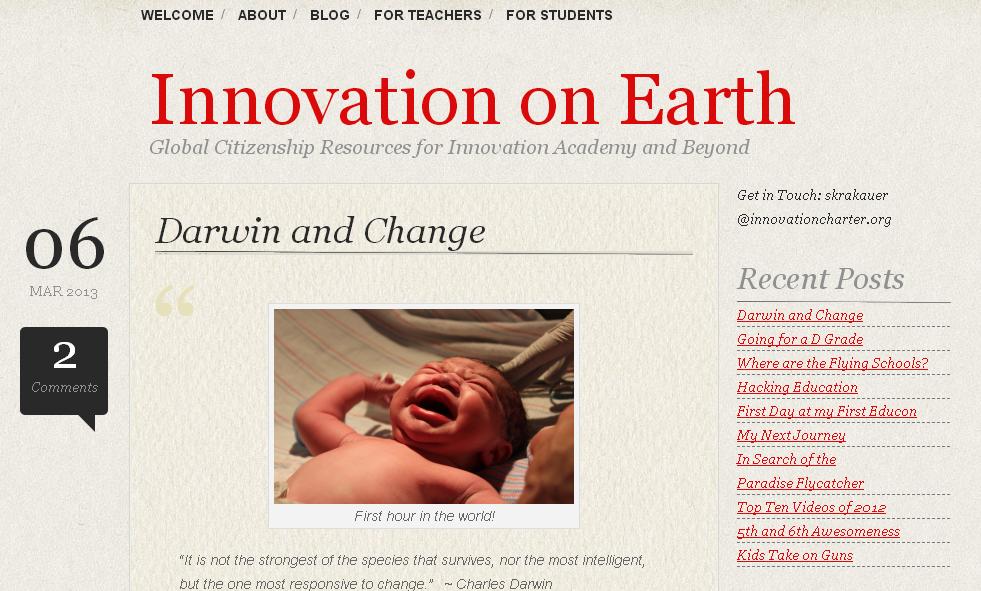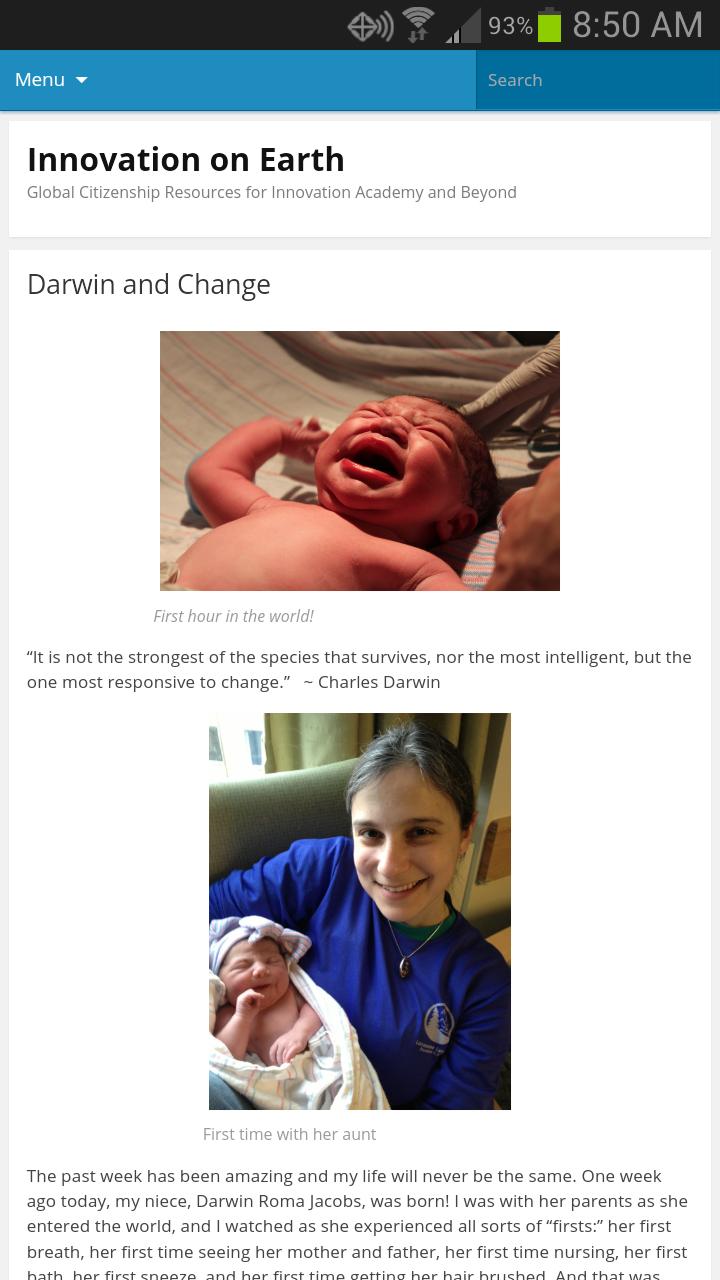 I wonder if there's a gene for blogging. Like me, my younger daughter Sara has a blog. Actually, she's created several of them. Note 1 Something happened with Sara's blog that made me think again about a decision I made three years ago when starting mine. See below what Sara's blog looked like on my desktop computer screen this morning, March 7, 2013. Click on it if you want to see it full-size (return with your "Back" button).  You'll notice that like me, Sara blogged about my new granddaughter (and Sara's niece) Darwin Roma (my entry last week was called Darwin). If I call up the exact same page as above on my Samsung Galaxy S III smart phone, here's what it looks like (click on it to enlarge it, and click a second time to see it full-size): Note 2  Note that Sara's blog was automatically reformatted when I viewed it on a smaller screen. Sara didn't have to do anything to cause this to happen. She simply used the service WordPress to host her blog. When large numbers of people started viewing these blogs on smaller screens, WordPress did the work necessary to cause them to be displayed more effectively in that environment, without any effort on Sara's part. My blog doesn't benefit from that, because I didn't use any such commercial service. This is because I wanted to have full control over the source form of my writing, which uses basic HTML (HyperText Markup Language) and JPEG image files only. I completely own all the files which comprise my blog, and I hope they will be readable for a long time, preferably centuries, no matter how the art advances, and no matter what happens ultimately to companies like WordPress. But this decision, explained in my early blog entry Why write using the HTML and JPG file formats?, certainly costs me. It costs me about 45 minutes every single time I post an entry, which is the time spent just hooking up the various pointers in the indexes and keyword lists (WordPress does all that automatically). It costs me the convenience of being able to be specially formatted for a smart phone, or any other small screen, without doing a lot of work myself (work which I don't think I'll bother with, though). Using a commercial service also makes it easier for people to find your blog. While mine is public (and indexed by search engines), it's not that easy to come across it. But then, it's mainly for my family and friends, so I don't really need to publicise it. A computer savvy friend thinks I'm crazy for not using a commercial site such as WordPress to host my blog (although I'm not sure WordPress would have been my choice when I started over three years ago - at that point in time, I probably would have chosen Blogspot). As of today, the WordPress statistics page says that WordPress is currently hosting 62,123,366 blogs, and "Over 389 million people view more than 3.6 billion pages each month." I'm sure that if you click on that link, you'll find the numbers to have gone up since I wrote this. But that doesn't mean that it can't possibly go away. My view is that WordPress is a for-profit private company, and anything can happen. My blog is not at the mercy of any single entity. The files comprising my blog exist in multiple locations. They're all on my own computer, of course. That means they're all backed up by the backup service Carbonite. They also can be found on the servers of PowWeb, which currently hosts the blog. And every now and then, I write the entire set of files out on a CD-ROM, and put it in my safe deposit box. All the files on all my web pages, which include my blog, a set of older pages, and Margie's pages at MargretKrakauer.com currently take up only 275 Megabytes on a CD-ROM. Since a CD-ROM can hold up to 700 Megabytes, I should have another four and a half years of blogging to go before I need to add a second disk. Actually, since I've been using larger and larger pictures, I may exceed one disk in less time than that. And of course, the disk version is always behind the actual blog, often by quite a few months. Of course, my blog's remaining in existence does depend on a continued ability to obtain browsers that can read basic HTML files. But that's not the same, in my mind, as being at the mercy of a single private company (and remember, when I started, I probably would have chosen Blogspot, not Wordpress). Click the next link if you want to see more of Sara's blog entry on Darwin. Sara was actually present at the birth, and she's an excellent photographer. In addition to several still pictures, it also contains an embedded YouTube video that Sara put together. If you're reading this 100 years after it was written, you can click on the above links to see if Sara's blog and/or the YouTube video are still there.
  Note 1: Here are some of Sara's blogs. Innovation on Earth - created for the benefit of her students at Innovation Academy Charter School, this is Sara's most current and frequently updated blog. On the right, if you Search, or browse the Archives, you'll find all sorts of interesting entries. For example: Globe Twisting Balloons - used for Sara's balloon twisting business. Although this looks like an ordinary business home page, it's built on the foundation of a blogging site. This site has sections on Sara's travel to: Sara's created several other blogs for travel groups she's led, but they're private, and password protected. However, you can look at Mali Mania, Sara's blog from a trip to Mali, in West Africa, in 2007. In Mali's Dogon Country, one leg of her journey was by piggyback. She visited a mosque made of mud (there's a picture of it in the blog), noting, "For the record, it's not the best idea to travel to a city of mud in Mali during the rainy season, but what can you do?". Here's an interview with Sara on a site called Teaching Traveling. [return to text] Note 2: You may be astounded, as I was when I first did this, at how enormous this image is, given that it is a "screen shot" from a hand-held smart phone, whose display is only 6 cm wide by 10.6 cm high (2.35 by 4.18 inches). But at 120.5 pixels per centimeter, the Galaxy S III packs quite a few pixels onto its small screen - the display is 720 pixels wide by 1280 pixels high. Turned sideways and transferred onto my desktop PC, the image covers 88 percent of the display. I'll have more to say about this in a subsequent blog entry. How did I get this screen image? I didn't have to take a picture of it with my camera. The Galaxy S III provides a simple way to do a "screen capture" (that is, to save as an image what is shown on its screen). You just swipe the edge of your open hand across the screen. You hear a camera-shutter noise, and it's done. In the image, you can see the black status bar at the top of the Galaxy's screen. In case you're wondering about the icons, here's what they mean, left to right: GPS services activated, Wi-Fi on, mobile phone signal strength, battery level as a percent, battery level graphically, and time of day. American that I am, I still prefer AM/PM indicators, rather than a 24-hour clock. [return to text]
 |